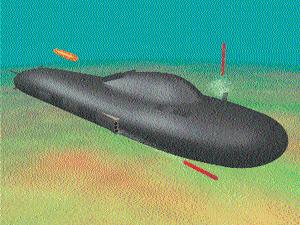Defense Science Board Supports Future Attack Submarine Development |
|
| “We need more, not fewer” attack submarines, the Defense Science
Board (DSB) task force on the “Submarine of the Future” concluded in its July
1998 report. Moreover, the DSB called for accelerating production of the New Attack
Submarine (Virginia class), while pursuing a vigorous technology development program in
preparation for a new and more capable successor in the 2020s. Chartered by the Under
Secretary of Defense for Research and Acquisition, the DSB task force conducted an
in-depth assessment of “how attack submarines should serve the nation’s defense
needs in the 21st century.” Included were questions about the role of the SSN within
the naval environment of the next ten - 20 years, the “ideal” submarine or force
mix for that purpose, and what “technology improvement barriers” needed to be
overcome for significant capability enhancements in future platforms. Describing the Virginia class as “a major step to the submarine of the future” and “a significant enabler for future growth,” the DSB task force recommended that it “continue and evolve” until a superior replacement is ready for production. Dismissing the suggestion for a force mix that includes diesel-electric submarines, the panel “firmly reaffirmed” that the Virginia-class follow-on should be a “large” nuclear ship offering high transit speed, independent logistics, and endurance – as well as the substantial internal volume necessary for unconventional payloads, such as auxiliary vehicles. Suggesting that “weapon-specific interfaces” such as torpedo and Vertical Launch System tubes be avoided, the group postulated “using ‘bomb bay’ techniques or other large aperture openings, coupled with external storage of rapid-response weapons.” In this concept, today’s torpedo room would be supplanted by a free-flooding weapons bay reconfigurable for a variety of weapon and offboard sensor payloads. The DSB panel motivated its findings by observing that the evolving world situation and the Navy’s turn toward the littorals make stealth, endurance, and mobility increasingly relevant, particularly for sea control and self protection in coastal regions. They offered four central observations. First, they noted that SSNs are so key to modern naval forces and capabilities that they could be called “a ‘crown jewel’ in America’s arsenal.” Second, the DSB remarked that since current force level forecasts are substantially lower than those recommended by the Quadrennial Defense Review in May 1997, the United States may require more, not fewer, SSNs. Third, for the future, the task force recommended that the traditional emphasis on SSN propulsion and quieting be shifted to “connectivity, sensors, weapons, adjuvant vehicles, and interfaces with the water.” And finally, the panel suggested that DoD needs to broaden participation and reallocate taskings in the research, development, acquisition, and performance verification of new SSN designs. Thus, they recommended a “wide open look” at the future submarine by the Navy and the Defense Advanced Research Projects Agency (DARPA), with substantial industry input to the development of alternatives. Subsequently, DARPA and the Navy have signed a Memorandum of Agreement to study future fast-attack submarine design concepts, with a focus on advanced payloads and sensor systems. |
|

